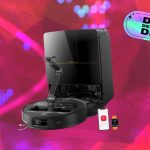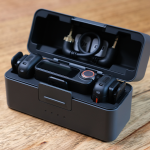
Celebrity chefs and influencer foodies make everything look so easy.
Food vloggers speed up a 20-step recipe into an Instagram video and make it look as simple as microwaved ramen. Antoni from Queer Eye is like, « Here, person with no cooking experience, let’s whip up some pork tenderloin canapés over a fire on this casual Tuesday night. »
But attempting an intricate recipe doesn’t have to be as intimidating as we make it out to be. Not with a pressure cooker, at least.
Instead of hoarding a separate countertop appliance for every different cooking method you may need, these multifaceted devices tackle functions from sautéing, to broiling, to cooking a pot roast in half the time (often even less) than a traditional slow cooker requires.
The Instant Pot and Ninja Foodi are far from the only options in the pressure cooker universe (more commonly known as the PCU), but they’re so far ahead of the competition that, in a way, they are the only options. The « Instant Pot vs. Ninja Foodi » debate is the center of countless articles, Reddit threads, and YouTube reviews. You can barely Google one without the other one popping up in autofill, and both are stars of Black Friday, Prime Day, and likely the Prime Early Access Sale.
Putting them head to head only makes sense.
Is the Ninja Foodi the same as the Instant Pot?
Not a yes, but not necessarily a no, either.
Instant Pot invented the electric pressure cooking game. Though the first Instant Pot model came out in 2008, the hype around a single kitchen device to do it all grew to unprecedented levels around 2015. People — both seasoned food enthusiasts and those who only cook out of necessity — obsessed over it so much that it felt like no appliance would ever even share the spotlight.
Ninja had a quieter entrance to the scene around 2018, when it diverted from the realm of fancy blenders to create the Foodi: a pressure cooker that doubled as an air fryer. At the time, the ability to offer both kitchen buzzwords in one device was more than Instant Pot could say.
Thus, it began.
Ninja and Instant Home are constantly growing their product lines to close gaps and compete with one another. On top of upgrades to the classic pressure cookers, both brands have expanded to non-pressure cooking air fryers that also do a ton of other stuff. The Instant Vortex, Instant Omni, and Ninja Speedi are the big ones. Totally not confusing at all!
But neither company is dumb — if a new rival cooker comes out with a novel cooking function added to its list of talents, it’s only a matter of time before the other company debuts a new cooker that can do the same thing. On top of their big functions (like pressure cooking, air frying, roasting, sous vide) both cookers have cooking presets that know the optimal time and temperature combo for things like salsas and dips, rice, soups, etc. There’s not really anything that a Foodi can do that an Instant Pot can’t, and vice versa — the real comparison is in variety of models and how much they cost.
If you’re up on Instant Pot lore, the harrowing screenshot of one online resale platform’s Instant Pot cemetery may be flashing in your mind. Maybe everyone’s over the idea of an appliance that does it all (though defrosting chicken in a few minutes seems reason enough not to bail) or maybe they’re just upgrading from their clunky 2019 Instant Pot to a new one that looks better and cooks more. (Black Friday numbers will be telling.) Either way, it’s a clear visual of the grasp that Instant Pot had on society a few years ago, and it’ll be interesting to see how the hype changes in the coming years.
Which is better: Ninja Foodi vs. the Instant Pot
The complicated answer to the Ninja Foodi vs. Instant Pot debate changes every time either brand launches a new iteration of its device. New releases happen much more often than you’d expect for the humble countertop cooker.
The blind spots each had a few years ago have mostly been covered at this point. (For instance, Instant Pot was leading the charge in more niche methods like yogurt making or sous vide for a while, but multiple Foodis do that now.)
Both have LCD screens, multiple pressure settings, inserts that are dishwasher safe, and the rest of those expected specs. Which cooker you should get depends on the appliance features that you want to pay for — and, honestly, which one you think would look slicker on your counter.
As of this writing, one lone true Foodi (the original pressure cooking and air frying combo) exists in two different sizes, retailing for between $279.99 and $349.99. Prices for the Instant Pot start at $89 and max out at $249.99, with a few models in between to ensure your perfect price point.
Keep reading as we dive deeper into where each device wins and loses, based off the models available as of October 2022.
Where Instant Pot wins: More models, more accessible pricing
« Instant Pot » is an umbrella term, though recent shuffling in the lineup has actually made differentiating easier rather than complicating it. Instant Home has consolidated into five main pressure cookers (as officially listed on the website, but popular discontinued models are still available at Amazon), preserving versatility while making comparisons easier.
The current Instant Pot lineup includes the most basic model, the 7-in-1 Duo for $99.99 (but on sale for as low as $49 during shopping holidays) through the most advanced model, the 11-in-1 Pro Crisp, for $249.95. Three models are in between. (We break down the differences here.) Every Instant Pot can pressure cook, slow cook, cook rice, steam, sauté, and warm, and as the models level up, more sophisticated features are added, like yogurt making, dehydrating, baking, or sous vide. There’s also a WiFi-enabled Instant Pot that makes it possible to start cooking or check food progress while you’re not standing at the counter. Ninja doesn’t have a WiFi model — yet.
(The Instant Pot Max also stands out with 15 PSI, which speeds up pressure cooking even more and opens the door for precise pressure canning. The Foodi maxes out at about 12 PSI.)
Models with « Crisp » in the title are obviously the air frying ones. But if you already have an Instant Pot, air frying can be added to most models with the separate air frying lid. (Non-compatible models with the air fryer lid include the Smart WiFi, Duo Evo Plus 6, Duo SV, and Max 60.)
Most Instant Pots are available in the popular 6-quart size as well as a mini 3-quart model and a family-friendly 8-quart model. (There is no 3-quart version of the Foodi.) The Instant Pot Duo Crisp with UltimateLid (which doesn’t require lid swapping for air frying versus pressure cooking) has a shorter, wider inner pot that is only available in 6.5 quarts, like the Foodi.
In terms cooking functionality alone, there’s negligible difference between what the most-loaded Instant Pot and the Foodi can do. Where Instant Pot pulls ahead is variety in price and function. Instant Pot models vary so widely to the point where they’re almost customizable to your skill and budget.
The best part is that if you don’t need all of those functions, Instant Pot won’t make you pay for them.
When the Instant Pot Max (the first Instant Pot with a sous vide feature) came out in 2018, it became very clear that the ability to hold water at a precise temperature for hours was a cooking function that people hold dear. Now, almost every new model that comes out is equipped with a sous vide feature, including a Duo model dedicated to sous vide. If this is one of your main requirements, Instant Pot has many more sous vide-ready options than Ninja does.
Where Instant Pot loses
Giving credit where it’s due, Instant Pot has closed the air frying gap that once put it at a serious disadvantage. It not only offers a variety of crisping models that come with the air frying lid as well as the lid for separate purchase for anyone who already has an Instant Pot, but now offers a model with a single lid that can do it all without swapping lids. That’s nothing special compared to the latest Foodi, which has a similar lid. The way to beat the Foodi would have been to make the lid completely removable rather than making the same mistake of using hinges, which has always been irksome about the Foodi. Small point deduction for that.
The Duo Crisp with the Ultimate Lid is the most similar (design and function wise) to the classic Foodi, so it makes the most sense to compare them. While Instant Home did upgrade to 6.5 quarts instead of its usual 6-quart, it doesn’t take as much advantage of the extra cooking space as Ninja does. It only includes one rack that makes it possible to cook two layers at once, while Ninja’s double-tiered rack can do three layers at a time.
Where Ninja Foodi wins: Meats!
Ninja has been perfecting its TenderCrisp technology for longer than Instant Brands, and anyone picky about balanced browning may feel better with that level of experience.
One Foodi model works particularly well for people who do a lot of roasting. The $349.99 Foodi Smart XL comes with a built-in thermometer that operates with the Smart Cook system, which uses four smart proteins settings and nine doneness levels.
Ninja capitalizes on its 6.5-quart capacity better than Instant Pot does. The included two-tiered rack bumps layered cooking possibilities up to three at a time. You could sear your steaks or 4-pound chicken on the bottom while cooking two side dishes above it — no need to keep up with three separate dishes on the stove or in the oven.
Whoever overhauled the Foodi’s physical design knew what they were doing. While the original models resembled Pokémon and took up more counter space than necessary, the latest Ninja Foodi XL sheds the huge side panels and adopts a clean-cut stainless steel design. It’s more expensive than any Instant Pot and looks like it, too.
Where Ninja Foodi loses
There are fewer ways to « customize » your cooker needs here, both function-wise and size-wise. Despite what seems like 20 different Foodi models, only one pressure cookers. There’s less clear scaling up in terms of what each model can do, and cookers that are dedicated toaster ovens or air fryers are still just called the Foodi — just with « XL » or « Deluxe » tacked onto the end. The true pressure cooking model only comes in 6.5 quarts or 8 quarts, skipping the mini 3-quart size that some Instant Pots come in.
While you can sometimes score an Instant Pot for as low as $50-ish if you’re fine with only six appliance functions, buying a Foodi locks you into spending $279.99 at full price or maybe $30 or $40 cheaper if you catch it on sale. And it’s a bummer that the Foodi costs so much and doesn’t even have a stainless steel insert. The ceramic isn’t as fragile as Teflon, but there are reports of chipping from the metal rack being pulled in and out. Some people also aren’t comfortable with their food chilling in a plastic-y coating for hours.
The verdict: It’s a toss-up
Both multicookers speed up cook time and take the guesswork out of recipes where nailing the right consistency is tricky. Both have undergone aesthetic changes that make them both chic as hell. When deciding between an Instant Pot and a Ninja Foodi, it comes down to how much you want to be able to do with your cooker. Groundbreaking statement — you’re welcome.
OK, there are a few caveats to consider. The first piece of criteria is easy: Do you care about air frying? If not, a more basic Instant Pot without the special lid can be purchased for a lot cheaper than a Foodi (which all air fry). If air frying is important to you, either cooker would be a great choice. As air fryers, both impress customers with speed and balanced crisping, so there’s no worry there. It may just come down to which model you think looks nicer, or you could go with the Foodi on the sole basis that it has three-layered cooking over the Instant Pot’s two.
If you’re the meat-with-every-meal type, you’ll appreciate the Foodi’s nine customizable doneness levels and the smart thermometer.
If you have low-hanging cabinets above your counter that probably won’t provide enough space for a non-removable lid to flip up, you’d be better off with a non-Ultimate Lid Instant Pot that comes with removable lids (go with a Crisp model if you want to air fry). Justice for people with low-hanging cabinets!
And if you think you’d utilize an app that can control the cooker and check food progress when you’re away from the counter, Instant Pot is the only one with a WiFi-enabled cooker.
The sheer variety Instant Pot offers through so many models may just give it enough to pull ahead. Being able to customize the features you want (at the price you want) rather than being stuck with a single pricey option makes pressure cooking and air frying more accessible.





